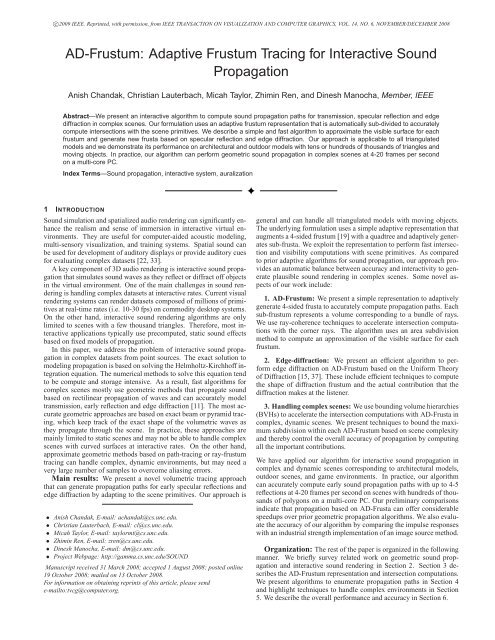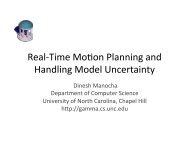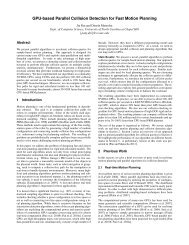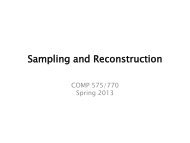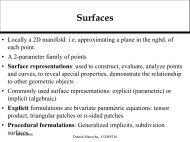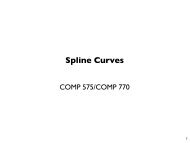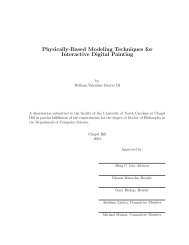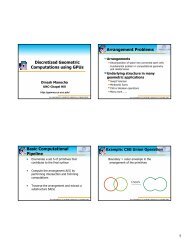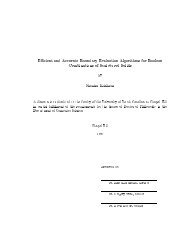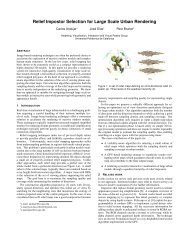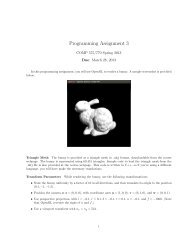Adaptive Frustum Tracing for Interactive Sound Propagation
Adaptive Frustum Tracing for Interactive Sound Propagation
Adaptive Frustum Tracing for Interactive Sound Propagation
You also want an ePaper? Increase the reach of your titles
YUMPU automatically turns print PDFs into web optimized ePapers that Google loves.
c○2009 IEEE. Reprinted, with permission, from IEEE TRANSACTION ON VISUALIZATION AND COMPUTER GRAPHICS, VOL. 14, NO. 6, NOVEMBER/DECEMBER 2008<br />
AD-<strong>Frustum</strong>: <strong>Adaptive</strong> <strong>Frustum</strong> <strong>Tracing</strong> <strong>for</strong> <strong>Interactive</strong> <strong>Sound</strong><br />
<strong>Propagation</strong><br />
Anish Chandak, Christian Lauterbach, Micah Taylor, Zhimin Ren, and Dinesh Manocha, Member, IEEE<br />
Abstract—We present an interactive algorithm to compute sound propagation paths <strong>for</strong> transmission, specular reflection and edge<br />
diffraction in complex scenes. Our <strong>for</strong>mulation uses an adaptive frustum representation that is automatically sub-divided to accurately<br />
compute intersections with the scene primitives. We describe a simple and fast algorithm to approximate the visible surface <strong>for</strong> each<br />
frustum and generate new frusta based on specular reflection and edge diffraction. Our approach is applicable to all triangulated<br />
models and we demonstrate its per<strong>for</strong>mance on architectural and outdoor models with tens or hundreds of thousands of triangles and<br />
moving objects. In practice, our algorithm can per<strong>for</strong>m geometric sound propagation in complex scenes at 4-20 frames per second<br />
on a multi-core PC.<br />
Index Terms—<strong>Sound</strong> propagation, interactive system, auralization<br />
1 INTRODUCTION<br />
<strong>Sound</strong> simulation and spatialized audio rendering can significantly enhance<br />
the realism and sense of immersion in interactive virtual environments.<br />
They are useful <strong>for</strong> computer-aided acoustic modeling,<br />
multi-sensory visualization, and training systems. Spatial sound can<br />
be used <strong>for</strong> development of auditory displays or provide auditory cues<br />
<strong>for</strong> evaluating complex datasets [22, 33].<br />
A key component of 3D audio rendering is interactive sound propagation<br />
that simulates sound waves as they reflect or diffract off objects<br />
in the virtual environment. One of the main challenges in sound rendering<br />
is handling complex datasets at interactive rates. Current visual<br />
rendering systems can render datasets composed of millions of primitives<br />
at real-time rates (i.e. 10-30 fps) on commodity desktop systems.<br />
On the other hand, interactive sound rendering algorithms are only<br />
limited to scenes with a few thousand triangles. There<strong>for</strong>e, most interactive<br />
applications typically use precomputed, static sound effects<br />
based on fixed models of propagation.<br />
In this paper, we address the problem of interactive sound propagation<br />
in complex datasets from point sources. The exact solution to<br />
modeling propagation is based on solving the Helmholtz-Kirchhoff integration<br />
equation. The numerical methods to solve this equation tend<br />
to be compute and storage intensive. As a result, fast algorithms <strong>for</strong><br />
complex scenes mostly use geometric methods that propagate sound<br />
based on rectilinear propagation of waves and can accurately model<br />
transmission, early reflection and edge diffraction [11]. The most accurate<br />
geometric approaches are based on exact beam or pyramid tracing,<br />
which keep track of the exact shape of the volumetric waves as<br />
they propagate through the scene. In practice, these approaches are<br />
mainly limited to static scenes and may not be able to handle complex<br />
scenes with curved surfaces at interactive rates. On the other hand,<br />
approximate geometric methods based on path-tracing or ray-frustum<br />
tracing can handle complex, dynamic environments, but may need a<br />
very large number of samples to overcome aliasing errors.<br />
Main results: We present a novel volumetric tracing approach<br />
that can generate propagation paths <strong>for</strong> early specular reflections and<br />
edge diffraction by adapting to the scene primitives. Our approach is<br />
• Anish Chandak, E-mail: achandak@cs.unc.edu.<br />
• Christian Lauterbach, E-mail: cl@cs.unc.edu.<br />
• Micah Taylor, E-mail: taylormt@cs.unc.edu.<br />
• Zhimin Ren, E-mail: zren@cs.unc.edu.<br />
• Dinesh Manocha, E-mail: dm@cs.unc.edu.<br />
• Project Webpage: http://gamma.cs.unc.edu/SOUND<br />
Manuscript received 31 March 2008; accepted 1 August 2008; posted online<br />
19 October 2008; mailed on 13 October 2008.<br />
For in<strong>for</strong>mation on obtaining reprints of this article, please send<br />
e-mailto:tvcg@computer.org.<br />
general and can handle all triangulated models with moving objects.<br />
The underlying <strong>for</strong>mulation uses a simple adaptive representation that<br />
augments a 4-sided frustum [19] with a quadtree and adaptively generates<br />
sub-frusta. We exploit the representation to per<strong>for</strong>m fast intersection<br />
and visibility computations with scene primitives. As compared<br />
to prior adaptive algorithms <strong>for</strong> sound propagation, our approach provides<br />
an automatic balance between accuracy and interactivity to generate<br />
plausible sound rendering in complex scenes. Some novel aspects<br />
of our work include:<br />
1. AD-<strong>Frustum</strong>: We present a simple representation to adaptively<br />
generate 4-sided frusta to accurately compute propagation paths. Each<br />
sub-frustum represents a volume corresponding to a bundle of rays.<br />
We use ray-coherence techniques to accelerate intersection computations<br />
with the corner rays. The algorithm uses an area subdivision<br />
method to compute an approximation of the visible surface <strong>for</strong> each<br />
frustum.<br />
2. Edge-diffraction: We present an efficient algorithm to per<strong>for</strong>m<br />
edge diffraction on AD-<strong>Frustum</strong> based on the Uni<strong>for</strong>m Theory<br />
of Diffraction [15, 37]. These include efficient techniques to compute<br />
the shape of diffraction frustum and the actual contribution that the<br />
diffraction makes at the listener.<br />
3. Handling complex scenes: We use bounding volume hierarchies<br />
(BVHs) to accelerate the intersection computations with AD-Frusta in<br />
complex, dynamic scenes. We present techniques to bound the maximum<br />
subdivision within each AD-<strong>Frustum</strong> based on scene complexity<br />
and thereby control the overall accuracy of propagation by computing<br />
all the important contributions.<br />
We have applied our algorithm <strong>for</strong> interactive sound propagation in<br />
complex and dynamic scenes corresponding to architectural models,<br />
outdoor scenes, and game environments. In practice, our algorithm<br />
can accurately compute early sound propagation paths with up to 4-5<br />
reflections at 4-20 frames per second on scenes with hundreds of thousands<br />
of polygons on a multi-core PC. Our preliminary comparisons<br />
indicate that propagation based on AD-Frusta can offer considerable<br />
speedups over prior geometric propagation algorithms. We also evaluate<br />
the accuracy of our algorithm by comparing the impulse responses<br />
with an industrial strength implementation of an image source method.<br />
Organization: The rest of the paper is organized in the following<br />
manner. We briefly survey related work on geometric sound propagation<br />
and interactive sound rendering in Section 2. Section 3 describes<br />
the AD-<strong>Frustum</strong> representation and intersection computations.<br />
We present algorithms to enumerate propagation paths in Section 4<br />
and highlight techniques to handle complex environments in Section<br />
5. We describe the overall per<strong>for</strong>mance and accuracy in Section 6.
Update Sources<br />
Update Listener<br />
Update BVH<br />
Query direct<br />
contribution<br />
Primary <strong>Frustum</strong><br />
AD−<strong>Frustum</strong><br />
Intersection<br />
with BVH<br />
{Δ1,..., ΔΚ}<br />
triangles<br />
Intersection<br />
with<br />
triangles<br />
Visible Surface Approximation<br />
Secondary <strong>Frustum</strong><br />
Specular Reflection<br />
+<br />
Edge Diffraction<br />
AD−<strong>Frustum</strong> (quadtree updated)<br />
Enumerate <strong>Propagation</strong> Paths<br />
Constribution to<br />
the listener<br />
Audio<br />
Rendering<br />
Query direct<br />
contribution<br />
Fig. 1. Overview of our algorithm: AD-Frusta are generated from sound sources (primary frusta) and by reflection and diffraction (secondary frusta)<br />
from the scene primitives. Approximate visible surfaces are then computed <strong>for</strong> each frustum (quadtree update). Next, each updated frustum checks<br />
if the listener lies inside it and is visible. If visible, its contributions are registered with the audio rendering system. The audio rendering system<br />
queries the direct contribution of a sound source every time it renders its audio block.<br />
2 PREVIOUS WORK<br />
The two main approaches to sound propagation are numerical methods<br />
and geometric approaches [11, 32]. In practice, the numerical<br />
solutions are too slow <strong>for</strong> interactive applications or dynamic scenes.<br />
In this section, we focus on geometric propagation techniques, which<br />
are primarily used to model early specular reflection and diffraction<br />
paths. Recently, techniques based on acoustic radiosity have also been<br />
developed to handle diffuse reflections <strong>for</strong> simple indoor scenes. At a<br />
broad level, the geometric propagation methods can be classified into<br />
ray-based or particle-based tracing, image source methods, and volumetric<br />
tracing.<br />
Ray-based or Particle-based Techniques: Some of the earliest<br />
methods <strong>for</strong> geometric sound propagation are based on tracing<br />
sampled-rays [16] or sound-particles (phonons) [14, 2, 6, 23] from a<br />
source to the listener. Recent improvements, including optimized hierarchies<br />
and exploiting ray-coherence, make it possible <strong>for</strong> ray-based<br />
and particle-based methods to handle complex, dynamic scenes on<br />
commodity hardware [39] or handle massive models [20]. However,<br />
due to discrete sampling of the space, these methods have to trace large<br />
number of paths or particles to avoid aliasing artifacts.<br />
Image Source Methods: These methods are the easiest and most<br />
popular <strong>for</strong> computing specular reflections [1, 5]. They compute virtual<br />
sources from a sound source recursively <strong>for</strong> every reflection and<br />
can have exponential complexity in the number of reflections. They<br />
can guarantee all specular paths up to a given order. However, they<br />
can only handle simple static scenes or very low order of reflections at<br />
interactive rates [17]. Many hybrid combinations [4] of ray-based and<br />
image source methods have also been proposed and used in commercial<br />
room acoustics prediction softwares (e.g. ODEON).<br />
Volumetric Methods: The volumetric methods trace pyramidal or<br />
volumetric beams to compute an accurate geometric solution. These<br />
include beam tracing that has been used <strong>for</strong> specular reflection and<br />
edge diffraction <strong>for</strong> interactive sound propagation [10, 17, 37, 9]. The<br />
results of beam tracing can be used to guide sampling <strong>for</strong> path tracing<br />
[10]. However, the underlying complexity of beam tracing makes it<br />
hard to handle complex models. Other volumetric tracing methods are<br />
based on triangular pyramids [8], ray-beams [25], ray-frusta [19], as<br />
well as methods developed <strong>for</strong> visual rendering [12].<br />
<strong>Interactive</strong> <strong>Sound</strong> <strong>Propagation</strong>: Various approaches have been<br />
proposed to improve the per<strong>for</strong>mance of acoustic simulation or handle<br />
complex scenarios. These include model simplification algorithms<br />
[13], use of scattering filters [36], and reducing the number of active<br />
sound sources by perceptual culling or sampling [38, 40]. These techniques<br />
are complementary to our approach and can be combined to<br />
handle scenarios with multiple sound sources or highly tessellated objects<br />
in the scene.<br />
3 ADAPTIVE VOLUME TRACING<br />
Our goal is to per<strong>for</strong>m interactive geometric sound propagation in<br />
complex and dynamic scenes. We mainly focus on computing paths<br />
that combine transmission, specular reflection, and edge diffraction up<br />
to a user-specified criterion from each source to the receiver. Given<br />
the underlying complexity of exact approaches, we present an approximate<br />
volumetric tracing algorithm. Fig. 1 gives a top level view of<br />
our algorithm. We start by shooting frusta from the sound sources.<br />
A frustum traverses the scene hierarchy and finds a list of potentially<br />
intersecting triangles. These triangles are intersected with the frustum<br />
and the frustum is adaptively sub-divided into sub-frusta. The<br />
sub-frusta approximate which triangles are visible to the frustum. The<br />
sub-frusta are subsequently reflected and diffracted to generate more<br />
frusta, which in turn are traversed. Also, if the listener is inside a<br />
frustum and visible, the contribution is registered <strong>for</strong> use during audio<br />
rendering stage.<br />
Our approach builds on using a ray-frustum <strong>for</strong> volumetric tracing<br />
[19]. We trace the paths from the source to the receivers by tracing<br />
a sequence of ray-frusta. Each ray-frustum is a simple 4-sided frustum,<br />
represented as a convex combination of four corner rays. Instead<br />
of computing an exact intersection of the frusta with a primitive,<br />
ray-frustum tracing per<strong>for</strong>ms discrete clipping by intersecting a fixed<br />
number of rays <strong>for</strong> each frustum. This approach can handle complex,<br />
dynamic scenes, but has the following limitations:<br />
• The <strong>for</strong>mulation uses uni<strong>for</strong>mly spaced samples inside each frustum<br />
<strong>for</strong> fast intersection computations. Using a high sampling<br />
resolution can significantly increase the number of traced frusta.<br />
• The approach cannot adapt to the scene complexity efficiently.<br />
In order to overcome these limitations, we propose an adaptive frustum<br />
representation, AD-<strong>Frustum</strong>. Our goal is to retain the per<strong>for</strong>mance<br />
benefits of the original frustum <strong>for</strong>mulation, but increase the accuracy<br />
of the simulation by adaptively varying the resolution. Various components<br />
of our algorithm are shown in Fig. 1.<br />
3.1 AD-<strong>Frustum</strong><br />
AD-<strong>Frustum</strong> is a hierarchical representation of the subdivision of a<br />
frustum. We augment a 4-sided frustum with a quadtree structure to<br />
keep track of its subdivision and maintain the correct depth in<strong>for</strong>mation,<br />
as shown in Fig. 2. Each leaf node of the quadtree represents the<br />
finest level sub-frustum that is used <strong>for</strong> volumetric tracing. An intermediate<br />
node in the quadtree corresponds to the parent frustum or an<br />
internal frustum. We adaptively refine the quadtree in order to per<strong>for</strong>m<br />
accurate intersection computations with the primitives in the scene and<br />
generate new frusta based on reflections and diffraction.<br />
Representation: Each AD-<strong>Frustum</strong> is represented using an apex<br />
and a quadtree. Each 2D node of the quadtree includes: (a) corner<br />
rays of the sub-frustum that define the extent of each sub-frustum;<br />
(b) intersection status corresponding to completely-inside, partiallyintersecting<br />
with some primitive, or completely-outside of all scene<br />
primitives; (c) intersection depth, and primitive id to track the depth<br />
value of the closest primitive; (d) list of diffracting edges to support<br />
diffraction calculations. We also associate a maximum-subdivision<br />
depth parameter with each AD-<strong>Frustum</strong> that corresponds to the maximum<br />
depth of the quadtree.<br />
3.2 Intersection Tests<br />
The AD-Frusta are used <strong>for</strong> volumetric tracing and enumerating the<br />
propagation paths. The main operation is computing their intersection<br />
with the scene primitives and computing reflection and diffraction
c○2009 IEEE. Reprinted, with permission, from IEEE TRANSACTION ON VISUALIZATION AND COMPUTER GRAPHICS, VOL. 14, NO. 6, NOVEMBER/DECEMBER 2008<br />
A P<br />
(a) (b)<br />
Fig. 2. AD-<strong>Frustum</strong> Representation: (a) A frustum, represented by convex<br />
combination of four corner rays and apex A. (b) A hierarchically<br />
divided adaptive frustum. It is augmented with a quadtree structure,<br />
where P is the 2D plane of quadtree. We use two sets of colors to<br />
show different nodes. Each node stores auxiliary in<strong>for</strong>mation about corresponding<br />
sub-frusta.<br />
frusta. The scene is represented using a bounding volume hierarchy<br />
(BVH) of axis-aligned bounding boxes (AABBs). The leaf nodes of<br />
the BVH are triangle primitives and the intermediate nodes represent<br />
an AABB. For dynamic scenes, the BVH is updated at each frame<br />
[39, 21, 43]. Given an AD-<strong>Frustum</strong>, we traverse the BVH from the<br />
root node to per<strong>for</strong>m these tests.<br />
Intersection with AABBs: The intersection of an AD-<strong>Frustum</strong><br />
with an AABB is per<strong>for</strong>med by intersecting the four corner rays of<br />
the root node of the quadtree with the AABB, as described in [26]. If<br />
an AABB partially or fully overlaps with the frustum, we apply the algorithm<br />
recursively to the children of the AABB. The quadtree is not<br />
modified during this traversal.<br />
Intersection with primitives: As a frustum traverses the BVH,<br />
we compute intersections with each triangle corresponding to the leaf<br />
nodes of the BVH. We only per<strong>for</strong>m these tests to classify the node as<br />
completely-inside, completely-outside or partially-intersecting. This<br />
is illustrated in Fig. 3, where we show the completely-outside regions<br />
in green and completely-inside regions in orange. This intersection<br />
test can be per<strong>for</strong>med efficiently by using the Plücker coordinate<br />
representation [31] <strong>for</strong> the triangle edges and four corner rays. The<br />
Plücker coordinate representation efficiently determines, based on an<br />
assumed orientation of edges, whether the sub-frustum is completely<br />
inside, outside or partially intersecting the primitive. This test is conservative<br />
and may conclude that a node is partially intersecting, even<br />
if it is completely-outside. If the frustum is classified as partiallyintersecting<br />
with the primitives, we sub-divide that quadtree node,<br />
generate four new sub-frusta, and per<strong>for</strong>m the intersection test recursively.<br />
The maximum-subdivision depth parameter imposes a bound<br />
on the depth of the quadtree. Each leaf node of the quadtree is classified<br />
as completely-outside or completely-inside.<br />
3.3 Visible Surface Approximation<br />
A key component of the traversal algorithm is the computation of the<br />
visible primitives associated with each leaf node sub-frustum. We use<br />
an area-subdivision technique, similar to classic Warnock’s algorithm<br />
[41], to compute the visible primitives. Our algorithm associates intersection<br />
depth values of four corner rays with each leaf node of the<br />
quadtree as well as the id of the corresponding triangle. Moreover,<br />
we compute the minimum and maximum depth <strong>for</strong> each intermediate<br />
node of the triangle, that represents the extent of triangles that partially<br />
overlap with its frustum. The depth in<strong>for</strong>mation of all the nodes<br />
is updated whenever we per<strong>for</strong>m intersection computations with a new<br />
triangle primitive.<br />
In order to highlight the basic subdivision algorithm, we consider<br />
the case of two triangles in the scene shown as red and blue in Fig. 3.<br />
In this example, the projections of the triangles on the quadtree plane<br />
overlap. We illustrate different cases that can arise based on the relative<br />
ordering and orientation of two triangles. The basic operation<br />
compares the depths of corner rays associated with the frustum and<br />
updates the node with the depth of the closer ray (as shown in Fig.<br />
3(a)). If we cannot resolve the closest depth (see Fig. 3(d)), we apply<br />
the algorithm recursively to its children (shown in orange). Fig.<br />
3(b) shows the comparison between a partially-intersecting node with<br />
a completely-inside node. If the completely-inside node is closer, i.e.,<br />
all the corner rays of the completely-inside node are closer than the<br />
minimum depth of the corner rays of the partially-intersecting node,<br />
then the quadtree is updated with the completely-inside node. Otherwise,<br />
we apply the algorithm recursively to their children as in Fig.<br />
3(e). Lastly, in Fig. 3(c), both the nodes are partially-intersecting and<br />
we apply the algorithm recursively on their children.<br />
This approach can be easily generalized to handle all the triangles<br />
that overlap with an AD-<strong>Frustum</strong>. At any stage, the algorithm maintains<br />
the depth values based on intersection with all the primitives traversed<br />
so far. As we per<strong>for</strong>m intersection computations with a new<br />
primitive, we update the intersection depth values by comparing the<br />
previous values stored in the quadtree. The accuracy of our algorithm<br />
is governed by the resolution of the leaf nodes of the quadtree, which<br />
is based on the maximum-subdivision depth parameter associated with<br />
each AD-<strong>Frustum</strong>.<br />
3.4 Nodes Reduction<br />
We per<strong>for</strong>m an optimization step to reduce the number of frusta. This<br />
step is per<strong>for</strong>med in a bottom up manner, after AD-<strong>Frustum</strong> finishes<br />
the scene traversal. We look at the children of a node. Since, each<br />
child shares atleast one corner-ray with its siblings, we compare the<br />
depths of these corner-rays. Based on the difference in depth values,<br />
the normals of the surfaces the sub-frustum intersects, and the acoustic<br />
properties of those surfaces we collapse the children nodes into the<br />
parent node. Thus, we can easily combine the children nodes in the<br />
quadtree that hit the same plane with similar acoustic properties. Such<br />
an approach can also be used to combine children nodes that intersect<br />
slightly different surfaces.<br />
4 ENUMERATING PROPAGATION PATHS<br />
In the previous section, we described the AD-<strong>Frustum</strong> representation<br />
and presented an efficient algorithm to compute its intersection and<br />
visibility with the scene primitives. In this section, we present algorithms<br />
to trace the frusta through the scene, and compute reflection<br />
and diffraction frusta. We start the simulation by computing initial<br />
frusta around a sound source in quasi-uni<strong>for</strong>m fashion [27] and per<strong>for</strong>m<br />
adaptive subdivision based on the intersection tests. Ultimately,<br />
the sub-frusta corresponding to the leaf nodes of the quadtree are used<br />
to compute reflection and diffraction frusta.<br />
Specular Reflections: Once a frustum has completely traced a<br />
scene, we consider all the leaf nodes within its quadtree and compute<br />
a reflection frustum <strong>for</strong> all completely-intersecting leaf nodes. The<br />
corner rays of sub-frustum associated with the leaf nodes are reflected<br />
(see Fig. 5) at the primitive hit by that sub-frustum. The convex combination<br />
of the reflected corner rays creates the parent frustum <strong>for</strong> the<br />
reflection AD-<strong>Frustum</strong>.<br />
4.1 Edge Diffraction<br />
Diffraction happens when a sound wave hits an object whose size is<br />
the same order of magnitude as its wavelength, causing the wave to<br />
scatter. Our <strong>for</strong>mulation of diffraction is based on the uni<strong>for</strong>m theory<br />
of diffraction (UTD) [15], which predicts that a sound wave hitting an<br />
edge between the primitives is scattered in a cone. The half-angle of<br />
the cone is determined by the angle that the ray hits the edge. The basic<br />
ray-frustum tracing algorithm can compute edge diffraction based on<br />
UTD [34]. This involves identifying diffraction edges as part of a<br />
pre-process and computing diffraction paths using frusta tracing. In<br />
this section, we extend the approach described in [34] to handle AD-<br />
Frusta.<br />
Finding diffracting edges: In a given scene, only a subset of the<br />
edges are diffraction edges. For example, any planar rectangle is represented<br />
by two triangles sharing an edge, but that edge cannot result in<br />
diffraction. Most edges in a model are shared by at least two triangles.<br />
As part of a pre-computation step, we represent the adjacency in<strong>for</strong>mation<br />
using an edge-based data structure that associates all edges that<br />
can result in diffraction with its incident triangles. As part of the tracing<br />
algorithm, we compute all triangles that intersect a sub-frustum.<br />
Next, we check whether the sub-frustum intersects any of the edges<br />
of that triangle and based on that update the list of diffracting edges
(a) (b) (c) (d) (e)<br />
Fig. 3. Visibility computation based on area subdivision: We highlight different cases that arise as we resolve visibility between two triangle<br />
primitives (shown in red and blue) from the apex of the frustum. In cases (a)-(b) the quadtree is refined based on the intersection depth associated<br />
with the outermost frustum and compared with the triangles. However, in cases (c)-(e) the outermost frustum has to be sub-divided into sub-frusta<br />
and each of them is compared separately.<br />
Fig. 4. Generating a diffraction frustum from an edge. The resulting<br />
wedge is shown as red and we show the generation of diffraction<br />
shadow frustum from the original sub-frustum. Note that the origin <strong>for</strong><br />
the frustum is not just the edge, but the whole area of the sub-frustum<br />
that overlaps the edge.<br />
<strong>for</strong> that sub-frustum. We per<strong>for</strong>m these tests efficiently using Plücker<br />
coordinates.<br />
Computing Diffraction Frusta: Our adaptive diffraction approach<br />
is similar to the diffraction <strong>for</strong>mulation described in [34, 37]. There<br />
are two main problems that arise in simulating edge diffraction using<br />
frusta: first, finding the shape of the new frustum that corresponds<br />
to the real diffraction as predicted by the UTD; second, computing<br />
the actual contribution that the diffraction makes to the sound at the<br />
listener.<br />
Given a diffraction edge, we clip the sub-frustum against the edge<br />
to find the interval along the edge that it intersects. The diffraction<br />
cone originates from the respective part of the edge and its orientation<br />
and shape are predicted by the UTD based on the angle of the edge.<br />
The angle is computed from the triangles incident to the edge. Notice<br />
that we per<strong>for</strong>m an approximation similar to [37] in that we ignore the<br />
non-‘shadow’ part of the diffraction. As part of frustum tracing, we<br />
ensure that the origin of the diffraction frustum is not limited to lie on<br />
the edge, but is chosen as the whole area of the frustum that overlaps<br />
the edge (see Fig. 4 <strong>for</strong> illustration). We compute this area by clipping<br />
the quadrilateral defined by the intersection of the frustum with the triangle’s<br />
plane against the triangle edge. This computation extends the<br />
frustum shape beyond the actual diffraction field originating from the<br />
edge. This has the important practical advantage that it will include<br />
the direct contribution of the original frustum <strong>for</strong> parts of the frustum<br />
that do not overlap with the triangle. As a result, this <strong>for</strong>mulation actually<br />
adds back direct contributions that would have been lost due to<br />
the discrete nature of the frustum representation. One special case occurs<br />
if just one corner of the frustum is inside the triangle, since in<br />
that case the clipped frustum has five edges. We handle this case by<br />
using a conservative bounding frustum and per<strong>for</strong>ming an additional<br />
check <strong>for</strong> inclusion when we compute all the contributions to the listener.<br />
Note that UTD is valid only <strong>for</strong> scenes with long edges, like the<br />
outdoor city scene or large walls and doors of architecture models. We<br />
there<strong>for</strong>e per<strong>for</strong>m edge-diffraction on such models.<br />
4.2 Contributions to the Listener<br />
For the specular reflections the actual contribution of a frustum is determined<br />
by finding a path inside all the frusta from the sound source<br />
to the listener. In case of diffraction, we have to ensure that the subfrustum<br />
is actually in the real diffraction shadow part of the frustum.<br />
There are three distinct possibilities: first, the sub-frustum can be part<br />
of the direct contribution as described above. In that case, the contribution<br />
is simply computed like a direct one. The second case is that<br />
the sub-frustum is not a direct one, but also not inside the diffraction<br />
cone, i.e. inside the conservative bounding frustum. In that case, it<br />
can be safely ignored. Finally, if the listener’s location is inside the<br />
diffraction frustum, we can compute the exact path due to all diffraction<br />
events. The UTD <strong>for</strong>mulation predicts the intensity of the sound<br />
field inside the diffraction cone, which depends on several variables,<br />
but most importantly the angle to the line of visibility (see [34, 37] <strong>for</strong><br />
more details). For the frustum representation, the equation can either<br />
be evaluated while computing the exact path, or per sub-frustum, i.e.<br />
by discretizing the equation. In our <strong>for</strong>mulation, we chose the latter<br />
such that the contribution can be evaluated very quickly per frustum,<br />
with a slight impact on the exact timing of the diffraction.<br />
5 COMPLEX SCENES<br />
In this section, we give a brief overview of how to govern the accuracy<br />
of our algorithm <strong>for</strong> complex scenes. The complexity of the<br />
AD-<strong>Frustum</strong> tracing algorithm described in Sections 3 and 4 varies<br />
as a function of the maximum-subdivision depth parameter associated<br />
with each AD-<strong>Frustum</strong>. A higher value of this parameter results in a<br />
finer subdivision of the quadtree and improves the accuracy of the intersection<br />
and volumetric tracing algorithms (see Fig. 5). At the same<br />
time, the number of leaf nodes can potentially increase as an exponential<br />
function of this parameter and significantly increase the number of<br />
traced frusta through the scene. Here, we present techniques <strong>for</strong> automatic<br />
computation of the depth parameter <strong>for</strong> each AD-<strong>Frustum</strong>. We<br />
consider two different scenarios: capturing the contributions from all<br />
important objects in the scene and constant frame-rate rendering.<br />
Our basic algorithm is applicable to all triangulated models. We do<br />
not make any assumptions about the connectivity of the triangles and<br />
can handle all polygonal soup datasets. Many times, a scene consists<br />
of objects that are represented using connected triangles. In the context<br />
of this paper, an object corresponds to a collection of triangles that are<br />
very close (or connected) to each other.<br />
5.1 Maximum-subdivision depth computation<br />
One of the main challenges is to ensure that our algorithm doesn’t<br />
miss the important contributions in terms of specular reflections and<br />
diffraction. We take into account some of the characteristics of geometric<br />
sound propagation in characterizing the importance of different<br />
objects. For example, many experimental observations have suggested<br />
that low-resolution geometric models are more useful <strong>for</strong> specular reflections<br />
[13, 36]. Similarly, small objects in the scene only have<br />
significant impact at high frequencies and can be excluded from the<br />
models in the presence of other significant sources of reflection and<br />
diffraction [10]. Based on these characterizations, we pre-compute geometric<br />
simplifications of highly tessellated small objects and assign<br />
an importance function to each object based on its size and material<br />
properties.<br />
Given an object (O) with its importance function, our goal is to ensure<br />
that the approximate frustum-intersection algorithm doesn’t miss<br />
contributions from that object. Given a frustum with its apex (A) and
c○2009 IEEE. Reprinted, with permission, from IEEE TRANSACTION ON VISUALIZATION AND COMPUTER GRAPHICS, VOL. 14, NO. 6, NOVEMBER/DECEMBER 2008<br />
(a) (b) (c) (d) (e) (f)<br />
Fig. 5. Beam tracing vs. uni<strong>for</strong>m frustum tracing vs. adaptive frustum tracing: We show the relative accuracy of three different algorithm in this<br />
simple 2D model with only first-order reflections. (a) Reflected beams generated using exact beam tracing. (b)-(c) Reflected frusta generated with<br />
uni<strong>for</strong>m frustum tracing <strong>for</strong> increased sampling: 2 2 samples per frustum and 2 4 samples per frustum. Uni<strong>for</strong>m frustum tracing generates uni<strong>for</strong>m<br />
number of samples in each frustum, independent of scene complexity. (d)-(e) Reflected frusta generated using AD-<strong>Frustum</strong>. We highlight the<br />
accuracy of the algorithm by using the values of 2 and 4 <strong>for</strong> maximum-subdivision depth parameter. (f) An augmented binary tree <strong>for</strong> the 2D case<br />
(equivalent to a quadtree in 3D) showing the adaptive frusta. Note that the adaptive algorithm only generates more frusta in the regions where the<br />
input primitives have a high curvature and reduces the propagation error.<br />
the plane of its quadtree (P), we compute a perspective projection of<br />
the bounding box of O on the P. Let’s denote the projection on P as<br />
o. Based on the size of o, we compute a bound on the size of leaf<br />
nodes of the quadtree such that the squares corresponding to the leaf<br />
nodes are inside o. If O has a high importance values attached to it,<br />
we ensure multiple leaf nodes of the quadtree are contained in o. We<br />
repeat this computation <strong>for</strong> all objects with high importance value in<br />
the scene. The maximum-subdivision depth parameter <strong>for</strong> that frustum<br />
is computed by considering the minimum size of the leaf nodes<br />
of the quadtree over all objects. Since we use a bounding box of O to<br />
compute the projection, our algorithm tends to be conservative.<br />
5.2 Constant frame rate rendering<br />
In order to achieve target frame rate, we can bound the number of<br />
frusta that are traced through the scene. We first estimate the number<br />
of frustum that our algorithm can trace per second based on scene<br />
complexity, number of dynamic objects and sources. Given a bound<br />
on maximum number of frusta traced per second, we adjust the number<br />
of primary frusta that are traced from each source. Moreover, we<br />
use a larger value of the maximum depth parameter <strong>for</strong> the first few<br />
reflections and decrease this value <strong>for</strong> higher order reflections. We<br />
compute the first few reflections with higher accuracy by per<strong>for</strong>ming<br />
more adaptive subdivisions. We also per<strong>for</strong>m adaptive subdivisions<br />
of a frustum based on its propagated distance. In this manner, our<br />
algorithm would compute more contributions from large objects in<br />
the scene, and tend to ignore contributions from relatively small objects<br />
that are not close to the source or the receiver. We can further<br />
improve the per<strong>for</strong>mance by using dynamic sorting and culling algorithms<br />
along with perceptual metrics [38].<br />
6 IMPLEMENTATION AND RESULTS<br />
In this section, we highlight the per<strong>for</strong>mance of our algorithm on different<br />
benchmarks, describe our audio rendering pipeline, and analyze<br />
its accuracy. Our simulations were run on a 2.66 GHz Intel Core 2<br />
Duo machine with 2GB of memory.<br />
6.1 Per<strong>for</strong>mance Results<br />
We per<strong>for</strong>m geometric sound propagation using adaptive frustum tracing<br />
on many benchmarks. The complexity of our benchmarks ranges<br />
from a few hundred triangles to almost a million triangles. The per<strong>for</strong>mance<br />
results <strong>for</strong> adaptive frustum tracing and complexity of benchmarks<br />
are summarized in Table 1. These results are generated <strong>for</strong> a<br />
maximum sub-division depth of 3. Further, the extent of dynamism in<br />
these benchmarks is shown in associated video. In Fig. 7, we show<br />
how the computation time <strong>for</strong> our approach and the number of frusta<br />
traced scale as we increase the maximum sub-division depth of AD-<br />
Frusta. Also, our algorithm scales well with the number of cores as<br />
shown in Fig. 8. The comparison of our approach with uni<strong>for</strong>m frustum<br />
tracing [19] is given in Table 2. We chose a sampling resolution of<br />
2 3 × 2 3 <strong>for</strong> uni<strong>for</strong>m frustum tracing and maximum sub-division depth<br />
of 3 <strong>for</strong> adaptive frustum tracing <strong>for</strong> the purposes of comparisons.<br />
Model Complexity Results (7 threads)<br />
#Δs diffraction #frusta time<br />
Theater 54 NO 56K 33.3 ms<br />
Factory 174 NO 40K 27.3 ms<br />
Game 14K NO 206K 273.3 ms<br />
Sibenik 71K NO 198K 598.6 ms<br />
City 78K YES 80K 206.2 ms<br />
Soda Hall 1.5M YES 108K 373.3 ms<br />
Table 1. This table summarizes the per<strong>for</strong>mance of our system on six<br />
benchmarks. The complexity of a model is given by the number of triangles.<br />
We per<strong>for</strong>m edge diffraction in two models and specular reflection<br />
in all. We use a value of 3 <strong>for</strong> the maximum sub-division depth <strong>for</strong> these<br />
timings. The results are computed <strong>for</strong> up to 4 orders of reflection.<br />
log(Time (msecs))<br />
log(#Frustua)<br />
10<br />
8<br />
6<br />
4<br />
Theater<br />
Factory<br />
Game<br />
Sibenik<br />
City<br />
Soda Hall<br />
2<br />
2 3 4 5<br />
Maximum Sub−division depth<br />
16<br />
14<br />
12<br />
10<br />
Theater<br />
Factory<br />
Game<br />
Sibenik<br />
City<br />
Soda Hall<br />
2 3 4 5<br />
Maximum Sub−division depth<br />
Fig. 7. This figure shows the effect of increasing the maximum subdivision<br />
depth of adaptive frustum tracing on the overall computation<br />
time of the simulation and the number of total frusta traced. Different<br />
colors are used <strong>for</strong> different benchmarks.<br />
6.2 Audio Rendering<br />
Audio rendering is the process of generating the final audio signal in<br />
an application. In our case, it corresponds to the convolution of the<br />
filter generated by sound propagation simulation with the input audio<br />
to produce the final sound at the receiver. In this section, we outline<br />
an audio rendering pipeline that can be integrated with our geometric<br />
propagation approach to per<strong>for</strong>m interactive audio rendering <strong>for</strong><br />
scenes with moving sources, moving listener, and dynamic objects.<br />
The two main methods <strong>for</strong> per<strong>for</strong>ming interactive audio rendering<br />
are “direct room impulse response rendering” and “parametric room
(a) (b) (c) (d)<br />
Fig. 6. Different Benchmarks: (a) Game Model with low geometric complexity. It has dynamic objects and a moving listener. (b) Sibenik Cathedral,<br />
a complex architectural model with a lot of details and curved geometry. It consists of moving source and listener, and a door that opens and closes.<br />
(c) City Scene with many moving cars (dynamic objects) and tall buildings which cause edge diffraction. It has a moving sound source, a static<br />
sound source, and a listener. (d) Soda Hall, a complex architectural model with multiple floors. The dimensions of a room are dynamically modified<br />
and the sound propagation paths recomputed <strong>for</strong> this new room using AD-Frusta. This scenario demonstrates the potential of our approach <strong>for</strong><br />
conceptual acoustic design.<br />
Speedup<br />
7<br />
6<br />
5<br />
4<br />
3<br />
2<br />
Theater<br />
Factory<br />
Game<br />
Sibenik<br />
City<br />
Soda Hall<br />
1<br />
1 2 3 4 5 6 7<br />
Number of Cores<br />
Fig. 8. This figure shows that our algorithm scales well with the number<br />
of cores. It makes our approach favorable <strong>for</strong> parallel and many-core<br />
plat<strong>for</strong>ms. Reflections <strong>for</strong> up to 4th order were computed and larger of<br />
maximum sub-division depths similar to those in Table 3 were used.<br />
Model Frusta traced Frusta Time<br />
UFT AFT Gain Gain<br />
Theater 404K 56K 7.2 6.1<br />
Factory 288K 40K 7.2 5.7<br />
Game 2330K 206K 11.3 9.0<br />
Sibenik 6566K 198K 33.2 21.9<br />
City 377K 78K 4.9 5.2<br />
Soda Hall 773K 108K 7.2 9.8<br />
Table 2. This table presents a preliminary comparison of the number of<br />
frusta traced and time taken by <strong>Adaptive</strong> <strong>Frustum</strong> <strong>Tracing</strong> and Uni<strong>for</strong>m<br />
<strong>Frustum</strong> <strong>Tracing</strong> [19] <strong>for</strong> results of similar accuracy. Our adaptive frustum<br />
<strong>for</strong>mulation significantly improves the per<strong>for</strong>mance as compared to<br />
prior approaches.<br />
impulse response rendering” [29]. In “direct room impulse response<br />
rendering”, impulse responses are pre-computed at some fixed listener<br />
locations. Next, the impulse response at some arbitrary listener position<br />
is computed by interpolating the impulse responses at nearby<br />
fixed listener locations. Such a rendering method is not very suitable<br />
when the source is moving or the scene geometry is changing.<br />
“Parametric room impulse response rendering” uses parameters like<br />
reflection path to the listener, materials of the objects in reflection path<br />
etc. to per<strong>for</strong>m interactive audio rendering. However, in this case it<br />
is important that the underlying geometric propagation system is able<br />
to update these parameters at very high update rates. Sandvad [28]<br />
suggests that update rates above 10 Hz should be used. In the DIVA<br />
system [29], an update rate of 20 Hz is used to generate artifact free<br />
audio rendering <strong>for</strong> dynamic scenes. We also use similar audio rendering<br />
techniques. Table 3 shows that we can update parameters at<br />
a high rate with maximum sub-division depth of 2 on a single core,<br />
as required by “Parametric room impulse response rendering”. Similar<br />
update rates <strong>for</strong> a sub-division depth of 3 on a single core can be<br />
achieved by decreasing the order of reflection or by updating the low<br />
order reflections more frequently than higher order reflections (see Ta-<br />
ble 3). Furthermore, we need to interpolate the parameters between<br />
the updates, as suggested in [42, 35], to minimize the artifacts due to<br />
the changing impulse responses. In order to demonstrate the accuracy<br />
of our propagation algorithm, we per<strong>for</strong>m audio rendering offline in<br />
some benchmarks. Also, the impulse responses used to generate the<br />
final rendered audio contain only early specular reflections and no late<br />
reverberation. This is done so it is easy to evaluate the effect of early<br />
reflections computed by our adaptive frustum tracing algorithm. Late<br />
reverberations can be computed as a pre-processing step [29] and can<br />
improve the audio quality.<br />
Order of Reflection Maximum<br />
Model Tris (Running time in msec) sub-division<br />
1st 2nd 3rd 4th depth<br />
Theater 54<br />
4.7<br />
24<br />
8.0<br />
77<br />
16.0<br />
201<br />
30.0<br />
462<br />
2<br />
4<br />
Factory 174<br />
3.3<br />
18<br />
6.7<br />
64<br />
12.7<br />
178<br />
24.7<br />
406<br />
2<br />
4<br />
Game Scene 14K<br />
20<br />
51<br />
46<br />
167<br />
120<br />
469<br />
270<br />
1134<br />
2<br />
3<br />
Sibenik 71K<br />
34<br />
67<br />
83<br />
236<br />
250<br />
864<br />
694<br />
2736<br />
2<br />
3<br />
City 72K<br />
6.7 12 23 44 2<br />
Soda Hall 1.5M<br />
18 38 85 174 3<br />
21 38 98 229 2<br />
35 102 297 723 3<br />
Table 3. This table shows the per<strong>for</strong>mance of adaptive frustum tracing<br />
on a single core <strong>for</strong> different maximum sub-division depths. The timings<br />
are further broken down according to order of reflection. Our propagation<br />
algorithm achieves interactive per<strong>for</strong>mance <strong>for</strong> most benchmarks.<br />
6.3 Accuracy and Validation<br />
Our approach is an approximate volume tracing approach and we<br />
can control its accuracy by varying the maximum-subdivision depth<br />
of each AD-<strong>Frustum</strong>. In order to evaluate the accuracy of propagation<br />
paths, we compare the impulse responses computed by our algorithm<br />
with other geometric propagation methods. We are not aware<br />
of any public or commercial implementation of beam tracing which<br />
can handle complex scenes with dynamic objects highlighted in Table<br />
1. Rather, we use an industry strength implementation of image<br />
source method available as part of CATT-Acoustic TM software.<br />
We compare our results <strong>for</strong> specular reflection on various benchmarks<br />
available with CATT software (see Fig. 9 and Fig. 10). The results<br />
show that our method gives more accurate results with higher maximum<br />
sub-division depths.<br />
7 ANALYSIS AND COMPARISON<br />
In this section, we analyze the per<strong>for</strong>mance of our algorithm and compare<br />
it with other geometric propagation techniques. The running time<br />
of our algorithm is governed by three main factors: model complexity,
c○2009 IEEE. Reprinted, with permission, from IEEE TRANSACTION ON VISUALIZATION AND COMPUTER GRAPHICS, VOL. 14, NO. 6, NOVEMBER/DECEMBER 2008<br />
amplitude<br />
Adaptve Volume <strong>Tracing</strong> (Source=S1, Listener=L1, Subdivision=2)<br />
0.9<br />
0.8<br />
0.7<br />
0.6<br />
0.5<br />
0.4<br />
0.3<br />
0.2<br />
0.1<br />
0<br />
0 2000 4000 6000 8000 10000<br />
time<br />
(c) 23 contributions<br />
(a) Theater benchmark<br />
amplitude<br />
Adaptve Volume <strong>Tracing</strong> (Source=S1, Listener=L1, Subdivision=4)<br />
0.9<br />
0.8<br />
0.7<br />
0.6<br />
0.5<br />
0.4<br />
0.3<br />
0.2<br />
0.1<br />
0<br />
0 2000 4000 6000 8000 10000<br />
time<br />
(d) 33 contributions<br />
amplitude<br />
0.9<br />
0.8<br />
0.7<br />
0.6<br />
0.5<br />
0.4<br />
0.3<br />
0.2<br />
0.1<br />
Image Source (Source=S1, Listener=L1)<br />
0<br />
0 2000 4000 6000 8000 10000<br />
time<br />
(b) 65 contributions<br />
amplitude<br />
Adaptve Volume <strong>Tracing</strong> (Source=S1, Listener=L1, Subdivision=5)<br />
0.9<br />
0.8<br />
0.7<br />
0.6<br />
0.5<br />
0.4<br />
0.3<br />
0.2<br />
0.1<br />
0<br />
0 2000 4000 6000 8000 10000<br />
time<br />
(e) 60 contributions<br />
Fig. 9. (a) Theater benchmark with 54 triangles. (b) Impulse response<br />
generated by image source method <strong>for</strong> 3 reflections. (c)–(e) Impulse<br />
responses generated by our approach with maximum sub-division depth<br />
of 2, 4, and 5 respectively <strong>for</strong> 3 reflections.<br />
level of dynamism in the scene, and the relative placement of objects<br />
with respect to the sources and receiver. As part of a pre-process, we<br />
compute a bounding volume hierarchy of AABBs. This hierarchy is<br />
updated as some objects in the scene move or some objects are added<br />
or deleted from the scene. Our current implementation uses a linear<br />
time refitting algorithm that updates the BVH in a bottom-up manner.<br />
If there are topological changes in the scene (e.g. explosions), than the<br />
resulting hierarchy can have poor culling efficiency and can result in<br />
more intersection tests [39]. The complexity of each frustum intersection<br />
test is almost logarithmic in the number of scene primitives and<br />
linear in the number of sub-frusta generated based on adaptive subdivision.<br />
The actual number of frusta traced also vary as a function of<br />
number of reflections as well as the relative orientation of the objects.<br />
7.1 Comparison<br />
The notion of using an adaptive technique <strong>for</strong> geometric sound propagation<br />
is not novel. There is extensive literature on per<strong>for</strong>ming adaptive<br />
supersampling <strong>for</strong> path or ray tracing in both sound and visual<br />
rendering. However, the recent work in interactive ray tracing <strong>for</strong> visual<br />
rendering has shown that adaptive sampling, despite its natural<br />
advantages, does not per<strong>for</strong>m near as fast as simpler approaches that<br />
are based on ray-coherence [39]. On the other hand, we are able to<br />
per<strong>for</strong>m fast intersection tests on the AD-Frusta using ray-coherence<br />
and the Plücker coordinate representation. By limiting our <strong>for</strong>mulation<br />
to 4-sided frusta, we are also able to exploit the SIMD capabilities of<br />
current commodity processors.<br />
Many adaptive volumetric techniques have also been proposed <strong>for</strong><br />
geometric sound propagation. Shinya et al. [1987] traces a pencil<br />
of rays and require that the scene has smooth surfaces and no edges,<br />
which is infeasible as most models of interest would have sharp edges.<br />
Rajkumar et al. [1996] used static BSP tree structure and the beam<br />
starts out with just one sample ray and is subdivided only at primitive<br />
intersection events. This can result into sampling problems due to<br />
missed scene hierarchy nodes. Drumm and Lam [2000] describe an<br />
adaptive beam tracing algorithm, but it is not clear whether it can handle<br />
complex, dynamic scenes. The volume tracing <strong>for</strong>mulation [12]<br />
shoots pyramidal volume and subdivides them in case they intersect<br />
with some object partially. This approach has been limited to visual<br />
rendering and there may be issues in combining this approach with a<br />
scene hierarchy. The benefits over the ray-frustum approach [19, 18]<br />
are shown in Fig. 5. The propagation based on AD-<strong>Frustum</strong> traces<br />
fewer frusta.<br />
In many ways, our adaptive volumetric tracing offers contrasting<br />
features as compared to ray tracing and beam tracing algorithms. Ray<br />
tracing algorithms can handle complex, dynamic scenes and can model<br />
diffuse reflections and refraction on top of specular reflection and<br />
diffraction. However, these algorithms need to per<strong>for</strong>m very high su-<br />
amplitude<br />
Adaptve Volume <strong>Tracing</strong> (Source=S1, Listener=L1, Subdivision=2)<br />
1.4<br />
1.2<br />
1<br />
0.8<br />
0.6<br />
0.4<br />
0.2<br />
0<br />
0 2000 4000 6000 8000 10000<br />
time<br />
(c) 23 contributions<br />
(a) Factory benchmark<br />
amplitude<br />
Adaptve Volume <strong>Tracing</strong> (Source=S1, Listener=L1, Subdivision=4)<br />
1.4<br />
1.2<br />
1<br />
0.8<br />
0.6<br />
0.4<br />
0.2<br />
0<br />
0 2000 4000 6000 8000 10000<br />
time<br />
(d) 32 contributions<br />
amplitude<br />
1.4<br />
1.2<br />
1<br />
0.8<br />
0.6<br />
0.4<br />
0.2<br />
Image Source (Source=S1, Listener=L1)<br />
0<br />
0 2000 4000 6000 8000 10000<br />
time<br />
(b) 40 contributions<br />
amplitude<br />
Adaptve Volume <strong>Tracing</strong> (Source=S1, Listener=L1, Subdivision=5)<br />
1.4<br />
1.2<br />
1<br />
0.8<br />
0.6<br />
0.4<br />
0.2<br />
0<br />
0 2000 4000 6000 8000 10000<br />
time<br />
(e) 41 contributions<br />
Fig. 10. (a) Factory benchmark with 174 triangles. (b) Impulse response<br />
generated by image source method <strong>for</strong> 3 reflections. (c)–(e) Impulse<br />
responses generated by our approach with maximum sub-division depth<br />
of 2, 4, and 5 respectively <strong>for</strong> 3 reflections.<br />
persampling to overcome noise and aliasing problems, both spatially<br />
and temporally. For the same accuracy, propagation based on AD-<br />
<strong>Frustum</strong> can be much faster than ray tracing <strong>for</strong> specular reflections<br />
and edge diffraction.<br />
The beam tracing based propagation algorithms are more accurate<br />
as compared to our approach. Recent improvements in the per<strong>for</strong>mance<br />
of beam tracing algorithms [24, 17] are promising and can<br />
make them applicable to more complex static scenes with few tens<br />
of thousands of triangles. However, the underlying complexity of per<strong>for</strong>ming<br />
exact clipping operations makes beam tracing more expensive<br />
and complicated. In contract, AD-<strong>Frustum</strong> compromises on the<br />
accuracy by per<strong>for</strong>ming discrete clipping with the 4-sided frustum.<br />
Similarly, image-source methods are rather slow <strong>for</strong> interactive applications.<br />
7.2 Limitations<br />
Our approach has many limitations. We have already addressed the<br />
accuracy issue above. Our <strong>for</strong>mulation cannot directly handle diffuse,<br />
lambertian or “glossy” reflections. Moreover, it is limited to<br />
point sources though we can potentially simulate area and volumetric<br />
sources if they can be approximated with planar surfaces. Many of the<br />
underlying computations such as maximum-subdivision depth parameter<br />
and intersection test based on Plücker coordinate representation<br />
are conservative. As a result, we may generate unnecessary sub-frusta<br />
<strong>for</strong> tracing. Moreover, the shape of the diffraction frustum may extend<br />
beyond the actual diffraction field originating from the edge. Limitations<br />
of UTD-based edge diffraction are mentioned in Section 4.1.<br />
Currently, our audio rendering system does not per<strong>for</strong>m interpolation<br />
of parameters, as suggested in [42, 35], and hence could result in some<br />
clicking artifacts when per<strong>for</strong>ming interactive audio rendering.<br />
8 CONCLUSION AND FUTURE WORK<br />
We present an adaptive volumetric tracing <strong>for</strong> interactive sound propagation<br />
based on transmissions, specular reflections and edge diffraction<br />
in complex scenes. Our approach uses a simple, adaptive frustum<br />
representation that provides a balance between accuracy and interactivity.<br />
We verify the accuracy of our approach by comparing the per<strong>for</strong>mance<br />
on simple benchmarks with commercial state-of-the-art software.<br />
Our approach can handle complex, dynamic benchmarks with<br />
tens or hundreds of thousands of triangles. The initial results seem
to indicate that our approach may be able to generate plausible sound<br />
rendering <strong>for</strong> interactive applications such as conceptual acoustic design,<br />
video games and urban simulations. Our approach maps well<br />
to the commodity hardware and empirical results indicate that it may<br />
scale linearly with the number of cores.<br />
There are many avenues <strong>for</strong> future work. We would like to use<br />
perceptual techniques [38] to handle multiple sources as well as use<br />
scattering filters <strong>for</strong> detailed geometry [36]. It may be possible to<br />
use visibility culling techniques to reduce the number of traced frusta.<br />
We can refine the criterion <strong>for</strong> computation of maximum-subdivision<br />
depth parameter based on perceptual metrics. It may be useful to use<br />
the Biot-Tolstoy-Medwin (BTM) model of edge diffraction instead of<br />
the UTD model [3]. We also want to develop a robust interactive audio<br />
rendering pipeline which can integrate well with UTD. Finally, we<br />
would like to extend the approach to handle more complex environments<br />
and evaluate its use on applications that can combine interactive<br />
sound rendering with visual rendering.<br />
ACKNOWLEDGEMENTS<br />
We thank Paul Calamia, Nikunj Raghuvanshi, and Jason Sewall <strong>for</strong><br />
their feedback and suggestions. This work was supported in part by<br />
ARO Contracts DAAD19-02-1-0390 and W911NF-04-1-0088, NSF<br />
awards 0400134, 0429583 and 0404088, DARPA/RDECOM Contract<br />
N61339-04-C-0043, Intel, and Microsoft.<br />
REFERENCES<br />
[1] J. B. Allen and D. A. Berkley. Image method <strong>for</strong> efficiently simulating<br />
small-room acoustics. The Journal of the Acoustical Society of America,<br />
65(4):943–950, April 1979.<br />
[2] M. Bertram, E. Deines, J. Mohring, J. Jegorovs, and H. Hagen. Phonon<br />
tracing <strong>for</strong> auralization and visualization of sound. In Proceedings of<br />
IEEE Visualization, pages 151–158, 2005.<br />
[3] P. Calamia and U. P. Svensson. Fast Time-Domain Edge-Diffraction Calculations<br />
<strong>for</strong> <strong>Interactive</strong> Acoustic Simulations. EURASIP Journal on Advances<br />
in Signal Processing, 2007.<br />
[4] B.-I. Dalenbäck. Room acoustic prediction based on a unified treatment<br />
of diffuse and specular reflection. The Journal of the Acoustical Society<br />
of America, 100(2):899–909, 1996.<br />
[5] B.-I. Dalenbäck and M. Strömberg. Real time walkthrough auralization -<br />
the first year. Proceedings of the Institute of Acoustics, 28(2), 2006.<br />
[6] E. Deines, M. Bertram, J. Mohring, J. Jegorovs, F. Michel, H. Hagen,<br />
and G. Nielson. Comparative visualization <strong>for</strong> wave-based and geometric<br />
acoustics. IEEE Transactions on Visualization and Computer Graphics,<br />
12(5), 2006.<br />
[7] I. A. Drumm and Y. W. Lam. The adaptive beam-tracing algorithm. Journal<br />
of the Acoustical Society of America, 107(3):1405–1412, March 2000.<br />
[8] A. Farina. RAMSETE - a new Pyramid Tracer <strong>for</strong> medium and large<br />
scale acoustic problems. In Proceedings of EURO-NOISE, 1995.<br />
[9] S. Fortune. Topological beam tracing. In SCG ’99: Proceedings of the<br />
fifteenth annual symposium on Computational geometry, pages 59–68,<br />
New York, NY, USA, 1999. ACM.<br />
[10] T. Funkhouser, I. Carlbom, G. Elko, G. Pingali, M. Sondhi, and J. West.<br />
A beam tracing approach to acoustic modeling <strong>for</strong> interactive virtual environments.<br />
In Proc. of ACM SIGGRAPH, pages 21–32, 1998.<br />
[11] T. Funkhouser, N. Tsingos, and J.-M. Jot. Survey of Methods <strong>for</strong> Modeling<br />
<strong>Sound</strong> <strong>Propagation</strong> in <strong>Interactive</strong> Virtual Environment Systems. Presence<br />
and Teleoperation, 2003.<br />
[12] J. Genetti, D. Gordon, and G. Williams. <strong>Adaptive</strong> supersampling in object<br />
space using pyramidal rays. Computer Graphics Forum, 17:29–54, 1998.<br />
[13] C. Joslin and N. Magnetat-Thalmann. Significant facet retrieval <strong>for</strong> realtime<br />
3D sound rendering. In Proceedings of the ACM VRST, 2003.<br />
[14] B. Kapralos, M. Jenkin, and E. Milios. Acoustic Modeling Utilizing an<br />
Acoustic Version of Phonon Mapping. In Proc. of IEEE Workshop on<br />
HAVE, 2004.<br />
[15] J. B. Keller. Geometrical theory of diffraction. Journal of the Optical<br />
Society of America, 52(2):116–130, 1962.<br />
[16] A. Krokstad, S. Strom, and S. Sorsdal. Calculating the acoustical room<br />
response by the use of a ray tracing technique. Journal of <strong>Sound</strong> and<br />
Vibration, 8(1):118–125, July 1968.<br />
[17] S. Laine, S. Siltanen, T. Lokki, and L. Savioja. Accelerated beam tracing<br />
algorithm. Applied Acoustic, 2008. to appear.<br />
[18] C. Lauterbach, A. Chandak, and D. Manocha. <strong>Adaptive</strong> sampling <strong>for</strong><br />
frustum-based sound propagation in complex and dynamic environments.<br />
In Proceedings of the 19th International Congress on Acoustics, 2007.<br />
[19] C. Lauterbach, A. Chandak, and D. Manocha. <strong>Interactive</strong> sound propagation<br />
in dynamic scenes using frustum tracing. IEEE Trans. on Visualization<br />
and Computer Graphics, 13(6):1672–1679, 2007.<br />
[20] C. Lauterbach, S.-E. Yoon, M. Tang, and D. Manocha. ReduceM: <strong>Interactive</strong><br />
and Memory Efficient Ray <strong>Tracing</strong> of Large Models. In Proc. of<br />
the Eurographics Symposium on Rendering, 2008.<br />
[21] C. Lauterbach, S.-E. Yoon, D. Tuft, and D. Manocha. RT-DEFORM: <strong>Interactive</strong><br />
Ray <strong>Tracing</strong> of Dynamic Scenes using BVHs. IEEE Symposium<br />
on <strong>Interactive</strong> Ray <strong>Tracing</strong>, 2006.<br />
[22] R. B. Loftin. Multisensory perception: Beyond the visual in visualization.<br />
Computing in Science and Engineering, 05(4):56–58, 2003.<br />
[23] F. Michel, E. Deines, M. Hering-Bertram, C. Garth, and H. Hagen.<br />
Listener-based Analysis of Surface Importance <strong>for</strong> Acoustic Metrics.<br />
IEEE Transactions on Visualization and Computer Graphics,<br />
13(6):1680–1687, 2007.<br />
[24] R. Overbeck, R. Ramamoorthi, and W. R. Mark. A Real-time Beam<br />
Tracer with Application to Exact Soft Shadows. In Eurographics Symposium<br />
on Rendering, Jun 2007.<br />
[25] A. Rajkumar, B. F. Naylor, F. Feisullin, and L. Rogers. Predicting RF<br />
coverage in large environments using ray-beam tracing and partitioning<br />
tree represented geometry. Wirel. Netw., 2(2):143–154, 1996.<br />
[26] A. Reshetov, A. Soupikov, and J. Hurley. Multi-level ray tracing algorithm.<br />
ACM Trans. Graph., 24(3):1176–1185, 2005.<br />
[27] C. Ronchi, R. Iacono, and P. Paolucci. The “Cubed Sphere”: A New<br />
Method <strong>for</strong> the Solution of Partial Differential Equations in Spherical Geometry.<br />
Journal of Computational Physics, 124:93–114(22), 1996.<br />
[28] J. Sandvad. Dynamic aspects of auditory virtual environment. In Audio<br />
Engineering Society 100th Convention preprints, page preprint no. 4246,<br />
April 1996.<br />
[29] L. Savioja, J. Huopaniemi, T. Lokki, and R. Väänänen. Creating interactive<br />
virtual acoustic environments. Journal of the Audio Engineering<br />
Society (JAES), 47(9):675–705, September 1999.<br />
[30] M. Shinya, T. Takahashi, and S. Naito. Principles and applications of<br />
pencil tracing. Proc. of ACM SIGGRAPH, 21(4):45–54, 1987.<br />
[31] K. Shoemake. Plücker coordinate tutorial. Ray <strong>Tracing</strong> News, 11(1),<br />
1998.<br />
[32] S. Siltanen, T. Lokki, S. Kiminki, and L. Savioja. The room acoustic<br />
rendering equation. The Journal of the Acoustical Society of America,<br />
122(3):1624–1635, September 2007.<br />
[33] S. Smith. Auditory representation of scientific data. In Focus on Scientific<br />
Visualization, pages 337–346, London, UK, 1993. Springer-Verlag.<br />
[34] M. Taylor, C. Lauterbach, A. Chandak, and D. Manocha. Edge Diffraction<br />
in <strong>Frustum</strong> <strong>Tracing</strong>. Technical report, University of North Carolina<br />
at Chapel Hill, 2008.<br />
[35] N. Tsingos. A versatile software architecture <strong>for</strong> virtual audio simulations.<br />
In International Conference on Auditory Display (ICAD), Espoo,<br />
Finland, 2001.<br />
[36] N. Tsingos, C. Dachsbacher, S. Lefebvre, and M. Dellepiane. Instant<br />
sound scattering. In Proceedings of the Eurographics Symposium on Rendering,<br />
2007.<br />
[37] N. Tsingos, T. Funkhouser, A. Ngan, and I. Carlbom. Modeling acoustics<br />
in virtual environments using the uni<strong>for</strong>m theory of diffraction. In Proc.<br />
of ACM SIGGRAPH, pages 545–552, 2001.<br />
[38] N. Tsingos, E. Gallo, and G. Drettakis. Perceptual audio rendering<br />
of complex virtual environments. ACM Trans. Graph., 23(3):249–258,<br />
2004.<br />
[39] I. Wald, W. Mark, J. Gunther, S. Boulos, T. Ize, W. Hunt, S. Parker, and<br />
P. Shirley. State of the Art in Ray <strong>Tracing</strong> Dynamic Scenes. Eurographics<br />
State of the Art Reports, 2007.<br />
[40] M. Wand and W. Straßer. Multi-resolution sound rendering. In SPBG’04<br />
Symposium on Point - Based Graphics 2004, pages 3–11, 2004.<br />
[41] J. Warnock. A hidden-surface algorithm <strong>for</strong> computer generated half-tone<br />
pictures. Technical Report TR 4-15, NTIS AD-753 671, Department of<br />
Computer Science, University of Utah, 1969.<br />
[42] E. Wenzel, J. Miller, and J. Abel. A software-based system <strong>for</strong> interactive<br />
sound synthesis. In International Conference on Auditory Display<br />
(ICAD), Atlanta, GA, April 2000.<br />
[43] S.-E. Yoon, S. Curtis, and D. Manocha. Ray <strong>Tracing</strong> Dynamic Scenes<br />
using Selective Restructuring. In Proc. of the Eurographics Symposium<br />
on Rendering, 2007.


